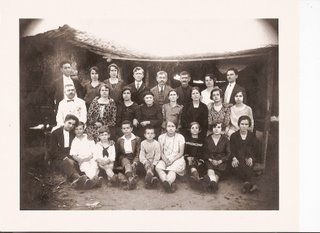
To most men , experience is like the stern light of a ship which il-luminates only the track it has passed. (Samuel Tylor Coleridge, British poet)
Wednesday, June 29, 2011
Floor Pumps: What's Your Favourite?
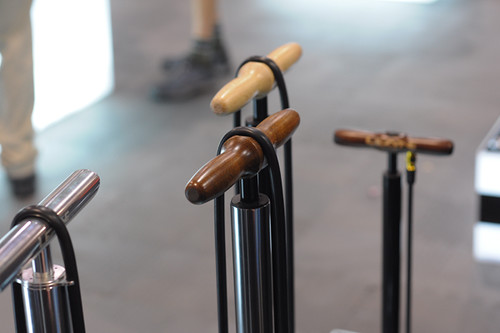
Occasionally I will hear from readers who are having trouble pumping their own tires, and inevitably the cause ends up being their bicycle pump. Sometimes it is simply a matter of the pump not accommodating their bicycle's valve system and the new cyclist not realising this. Other times, the pump's chuck (the part that fits onto the valve) is difficult to get on and off without causing damage.There are also those who lacksufficient upper body strength to operate their pump effectively.
As someone who can pump my own tires despite poor upper body strength and poor dexterity, one thing I can say is that the pump matters a great deal. It surprises me how many cyclist initially plan to get by with just the hand-held pump they bought for their tool bag. Floor pumps are much easier to use than hand-held pumps, requiring considerably less effort to operate.
But not all floor pumps are made equal. At home I use a Pedros Racing Service floor pump and have had no complaints about it over the years. However, this model is no longer in production and I've read mixed reviews about the current Pedro models. I have also tried enough floor pumps to know that some can be difficult and awkward to use. When readers ask for recommendations I am not sure what to suggest.
My general thoughts on what makes a good floor pump are that it ought to:
. be sufficiently heavy so as to remain stable in use (steel barrel),
. require a reasonable amount of force to operate,
. have an accurate pressure gauge,
. have a dual head to accommodate Presta and Schrader valves,
. have a chuck that is easy for the average person to fit and remove.
What is your favourite bicycle floor pump? Recommendations and suggestions are most welcome.
Tuesday, June 28, 2011
On the Road without a Roadbike
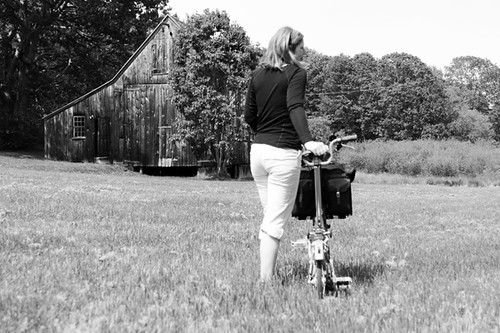
I like fast roadbikes, clipless pedals, bicycle computers, GPS, all of it. I do not subscribe to any philosophy that maligns these things in favour of the "slow bicycle movement" or whatever is the latest catch phrase to describe plain old regular bike riding. But I do believe in plain old regular bike riding, and sometimes I prefer it to any other kind. What are those times and what determines them, I couldn't tell you. It just happens.
When I went to Ireland last month I could have arranged to borrow a roadbike there, but opted against it - instead bringing along a folding bike that would have me riding upright the entire time. I knew I'd be slower and have more difficulty in the hilly areas, but somehow it just felt right to do it this way. I did not bring any cycling clothes. I did not bring a bicycle computer or a GPS device. Every day I simply looked at the map before setting off, then wrote out directions on a piece of paper. I explored interesting backroads and allowed myself to get lost. Occasionally I stopped to ask for directions. I did not miss my GPS. And I felt finehaving no idea how fast or slow I was going. What did it matter if I stopped every 20 minutes to take pictures anyhow.
Probably at least part of the reason I chose to do things this way, was to see how I would feel after more than two weeks without a roadbike - without that rush I get from the speed, without the reassuring glare of the computer screen and without the ritual of putting on the special clothing I'd gotten accustomed to.
But moreover, I have found that I prefer to ride slower and more upright when the focus of the ride is on exploring the surrounding area and not on cycling in of itself. Having never been to Ireland before, I really wanted to experience it as a human on a bicycle, rather than as a cyclist. And yes, there is a difference. Even the wearing of regular clothing and shoes played a role in this. The way people react to me is different, and the way I feel in the environment is different.
Now that I know the place better, now that it's more familiar, next time I would love to do some fast road rides along the Antrim coast. To ride through the glens on skinny tires, bent over my handlebars and pedaling as fast as I can. Bliss. A different sort of bliss than this time.
The more experience I gain with different types of bikes and different styles of cycling, the more I feel that the main thing is just to be out there, on your own terms. We like to define things, to draw boundaries. But often those boundaries are self-imposed. The road is calling. The bike is up to you.
Speaking of Saddles

Earlier this week I was visiting Cycle Loft - a local bicycle shop known, among other things, for its extensive fit studio.I will be test riding a few of their bikes this summer, and the staff suggested I undergo a fitting session beforehand. As we were getting started, the fitter - Joel - caught sight of the Selle Anatomica I was riding. He asked whether I wanted to use my own saddle, given how particular it was, or try something new.
Today there are lots of high quality, well thought-out saddle designs on the market, in a variety of materials. The trick is to find one that fits our particular anatomy, position and riding style. For the past two years I've been going back and forth between a Berthoud touring saddle and a Selle Anatomica on my roadbikes. These saddles are as close as I've been able to get to being truly comfortable over long distances. But neither is perfect. SoI decided to keep an open mind and see what the fitter recommended.
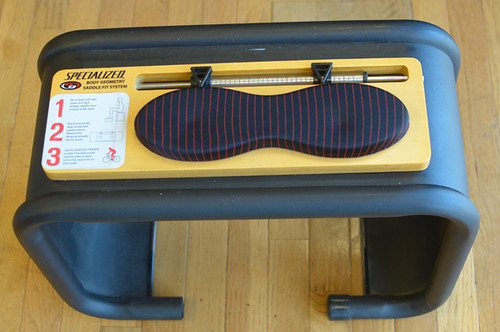
To start with, Joel measured my sit bones. This is something I've never had done "professionally" before, so it was pretty exciting. Cycle Loft uses the Specialized "Body Fit" method, which, as I understand it, is comparatively un-intrusive (no pelvic fondling, etc.). But there is a nifty device involved. A stool was brought out with a butt-shaped pillow, upon which I sat as instructed. When I stood up, my sit bones left two clear indentations, which Joel swiftly measured.
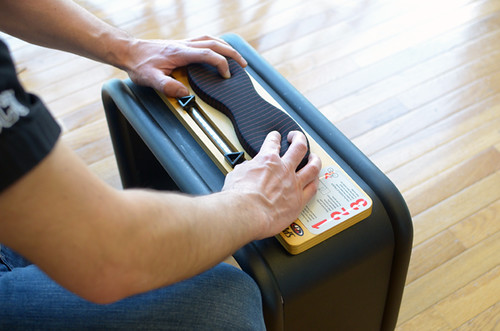
The figure was 135mm - considerably narrower than what I thought my sit bone width was based on my DIY measurements (the figure I'd come up with was more like 150mm). But we repeated the process just to make sure and got the same number again - so looks like 135mm it is.
Joel explained that a saddle should be wider than the sit bone width itself. How much wider depends partly on the rider's position and partly on the saddle's shape. As far as the rider's position, the more leaned forward you are, the narrower area of support is needed. That much I'd known. As far as saddle shape, Joel showed me a selection or road/racing saddles and pointed out that on some the sitting surface was flat across, while on others it was rounded, like an arc. For all my careful scrutiny of saddle shapes, this was not a distinction I'd explicitly been aware of before, so I was excited to learn something new. For any given rider, on a rounded saddle the width needs to be greater than on a flat saddle.
According to the fit chart, the saddle width recommended for my sit bones was 155mm minimum. My Berthoud saddle (which is flat) measures 160mm across, and my Selle Anatomica (which is rounded) measures 170mm across. My comfort with both makes sense according to this fit method.
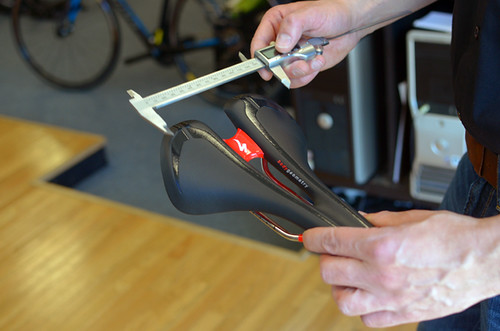
Next, Joel asked what I liked and disliked about the saddles I normally use. I explained that my saddles are fairly wide across the rear, yet have narrow, racing-style noses. The wide rear and narrow nose combination works for me, because this waymy butt feels fully supported but I don't get thigh-rub. Other saddles I've tried tend to be either too narrow or too wide all around, which doesn't work. I also like the feel of suspended leather, compared to other surfaces I've tried.
As far as what I don't like, that is a little trickier to explain. The Berthoud feels a bit too hard, whereas the Selle Anatomica has a bit too much give. And with each, I occasionally - at random times, it seems - feel pressure or pinching in the middle of my "soft tissue." It happens rarely now compared to the problems I used to have, but it does still happen occasionally. We discussed all this in detail, as well as the other saddles I've tried. I described my dislike of gel (I sink into it and feel horrible pressure), my inability to ride Terry saddles (the slots are somehow in the wrong place), and finding the edges of many racing saddles "too sharp" as I pedal.
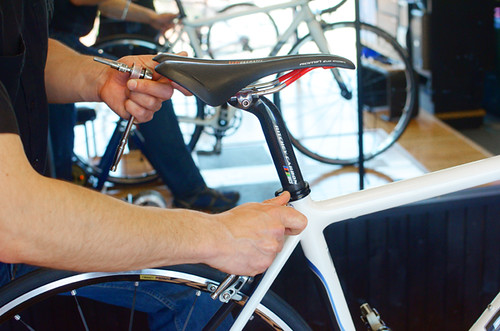
After taking all of this in, Joel suggested I try the Romin Evo saddle by Specialized (interesting write-up about it here). It had everything I seemed to need: a rounded wide rear (168mm across), a narrow nose, and a firm, but not rock-hard, surface. A channel down the middle and a curved nose were designed to avoid contact with exactly the pressure-prone spots I'd identified. It is not a woman-specific saddle, but then neither are my own. A synthetic saddle made by a big-name manufacturer, it was not what I would normally gravitate toward, but I'd said I would be open minded, and so I would.
The Romin Evo is now fitted on the demo bikeI'm riding. I could not feel it under me on the initial 30 mile ride, but I will withhold judgment until after the follow-up, 100K ride.
But whether this particular saddle wins me over is beside the point. What I appreciated the most was the generally informative conversation with the fitter - who I felt was neutral and knowledgeable when it came to various styles, materials, aesthetics and brands of saddles. I would like to keep learning myself, and at some point to post a comprehensive guide that might be of help to those at a loss for where to start.
Monday, June 27, 2011
Waterspouts on Pamlico Sound
One nice thing about staying put in areas for a longer period of time, is that we learn things from the people there that we wouldn't know otherwise. For example, when I got to work today someone asked me if I saw the waterspouts out there. I had no idea what a waterspout was. They said go and look out the window and look up at the sky. Once I saw it, I had no idea how I missed it on my way to work. I called Nathan and sent him out to take some pictures of them.
 Waterspouts are tornadoes that are over the water instead of land. And they are something else to watch.
Waterspouts are tornadoes that are over the water instead of land. And they are something else to watch.


 You learn something new every day!
You learn something new every day!
 Waterspouts are tornadoes that are over the water instead of land. And they are something else to watch.
Waterspouts are tornadoes that are over the water instead of land. And they are something else to watch.

 You learn something new every day!
You learn something new every day! Saturday, June 25, 2011
Central Kansas :: Another Sunset
Sunday, May 8th - - After my brief visit at Mushroom Rock State Park I continued west a short distance to Ellsworth. Then I spent a few hours driving around Russell County, part of which lies north of Interstate 70, and Barton County, which is to the south of Russell County and also south of I-70. You may be asking, Why?
After residing in Iowa for a short time (circa 1866-1868), my third great-grandparents, Lysander and Lydia (Robison) Joslin returned to Whitley County, Indiana. In 1877 they once again sold their land in Whitley County and headed west, this time to Odin, Cheyenne Township, Barton County, Kansas. Here they remained until 1891 when they moved to near Lyndon in Osage County in eastern Kansas.
I really couldn't do research – it was Sunday! Poor timing on my part. I did make a stop at the library in Great Bend for several hours and took a look at some of the books they had. Basically, I simply wanted to see what the countryside was like. The terrain to the north of I-70 differs dramatically from the land that lies to the south, at least in that immediate area. Russell County north of I-70 has hills, large hills. And gullies, deep and big. Southern Russel County and most of Barton County are relatively flat in comparison. Good farming land.
I considered staying in the area another night but decided against it, for various reasons. Instead I continued west on State Road 4 and stopped for the night at Cedar Bluff State Park near the small town of Brownell. It was another hot and windy day, with the temperature nearly reaching 100 degrees. And the air conditioning in the van wasn't working.
The site I had selected was in the shade near the beach. Even in the shade the heat was almost unbearable and I was thankful for the strong breeze that was blowing. My neighbors were a nice young couple. We weren't so lucky with the group that arrived in the early evening. They were loud with the stereo blaring, really inconsiderate. After about 15 minutes I left to find another site (it was a self-serve campground) in another area of the park. The new site turned out to be much better – flush toilets nearby! ;-)
It was also a better campsite because it offered a very nice view of the lake and the sunset, which was once again highly colorful due to the hazy sky. Thankfully, once the sun went down it cooled off considerably!




After residing in Iowa for a short time (circa 1866-1868), my third great-grandparents, Lysander and Lydia (Robison) Joslin returned to Whitley County, Indiana. In 1877 they once again sold their land in Whitley County and headed west, this time to Odin, Cheyenne Township, Barton County, Kansas. Here they remained until 1891 when they moved to near Lyndon in Osage County in eastern Kansas.
I really couldn't do research – it was Sunday! Poor timing on my part. I did make a stop at the library in Great Bend for several hours and took a look at some of the books they had. Basically, I simply wanted to see what the countryside was like. The terrain to the north of I-70 differs dramatically from the land that lies to the south, at least in that immediate area. Russell County north of I-70 has hills, large hills. And gullies, deep and big. Southern Russel County and most of Barton County are relatively flat in comparison. Good farming land.
I considered staying in the area another night but decided against it, for various reasons. Instead I continued west on State Road 4 and stopped for the night at Cedar Bluff State Park near the small town of Brownell. It was another hot and windy day, with the temperature nearly reaching 100 degrees. And the air conditioning in the van wasn't working.
The site I had selected was in the shade near the beach. Even in the shade the heat was almost unbearable and I was thankful for the strong breeze that was blowing. My neighbors were a nice young couple. We weren't so lucky with the group that arrived in the early evening. They were loud with the stereo blaring, really inconsiderate. After about 15 minutes I left to find another site (it was a self-serve campground) in another area of the park. The new site turned out to be much better – flush toilets nearby! ;-)
It was also a better campsite because it offered a very nice view of the lake and the sunset, which was once again highly colorful due to the hazy sky. Thankfully, once the sun went down it cooled off considerably!




Friday, June 24, 2011
OUT

Tuffee knows when I tell her OUT she is to get out of the horse pen. This is her slipping out the gate. She knows how to push it open just enough she can get out.
Thursday, June 23, 2011
Monday, June 20, 2011
Joslin Family :: Grandma Responds to Irwin's Letter
If you haven't already done so, you may want to read the post Joslin Family :: First Contact before continuing. In that post, my grandmother corresponds with Edith Wessler and makes contact with her 2nd cousin, Irwin Joslin. Their correspondence continues... This letter was typewritten. It has been transcribed as written including spelling and typing errors. Click on the image to view a larger, readable version.
=+==+==+==+=

Box 27
North Webster, Ind. 46555
March 21, 1969
Mr. Irwin Joslin
1002 E. Tripp
Peoria, Ill. 61603
Dear Mr. Joslin,
I was so delighted to receive your letter of March 3rd as I had been hoping to hear from the Joslins in the west. I have so many interesting things to tell you of the family, that I hardly know where to begin.
You were right about the birthdate of your grandfather as my records show that he was born January 2, 1852. Then the record shows that Luther Joslin married Dorothy Elliot in 1876. Now may I make a suggestion? Could the above named Dorothy Elliot have died and your grandfather married Phoebe Dorcas some time later? I notice that your father, Virgil was born Feb. 1891. That is 15 years after the marriage record I have, I am having a copy made of the letter written by Andrew Joslin on Feb. 7, 1895 and sent to my grandmother. I will send this to you as soon as I can.
Now I shall tell you some of the things I know about our family, other than that which Mrs. Wessler has told you. The Goodrich family tree has been researched by a member of the family and it seems that they were from Wales and the line was traced back to several Kings(?). This is not of much interest to me as I expect some researcher made some money for this. However, the family was very interesting after coming to Indiana in 1834. They were of the first settlers. Abagail and her husband James Joslin had several children by that time. Lysander was 9 years old. He married Lydia Robison in Aug. 1843. They were both 18 years old. In the next 24 years they had 15 children. Now this was a big family by any standards and I know where the family lived and it was very poor land. They did not prosper financialy as can be understood. By 1877 four of their children were married and five had died. That year they took the 6 remaining children and went to Kansas. I have letters from them written in 1890 and 1894.
My grandmother kept in touch with Eliza, who died in 1885. Her decendents are in Iowa. She also wrote to Roxie Parkinson (their husbands were half brothers) and Madella Quillan and Ida Dressier. I have some old letters from these. Robert Quillan the author and columnist of the 30's was Della's son. Please ask any questions that you would like answered and I shall do my best to help.
Grandma Mellisa Brubaker had two sons, Charles Romain b. Aug. 1872 and Hale b1886. Charles Remain was my father. Hale died when only 25 years old and had not married. I have a brother William Hale Brubaker and a sister Jane Jacobs. I was born 1902, my sister 1903 and Bill 1905. I Have 5 children, 17 granchildren and 7 great-granchildren.
I do hope that you can come to Indiana some time. I know of only one Joslin family here, besides my family and that is the decendents of Lysander's sister, her granddaughter and I are very close friends. I shall send the copy as soon as I can.
Very sincerely yours,
[since this was grandma's carbon copy, there was no signature]
=+==+= Some Notes Regarding the Letter =+==+=
The confusion over Luther's wife was partially because the bible record stated that Luther had married Dorothy Elliot. Apparently grandma had not seen the Whitley County marriage record (Bk2 p521) which gives her name as Phebe D. Elliott. Also, in Irwin's first letter to grandma he simply wrote his grandmother's name as Phoebe Dorcas and my grandma interpreted that to mean her maiden name was Dorcas. Irwin's father, Virgil, was the fourth child of Luther and Phebe. Their first two children came rather quickly then there was a six year gap between the second and third as well as between the third and fourth child. Their fifth (and last) child was born two years after Virgil.
James and Abigail come to Whitley County in 1838 and they were among the first settlers in the county. That makes Lysander about 13 at the time rather than 9 years of age.
The sister of Lysander's that grandma mentions in the last paragraph was Emily Eliza Joslin Long and her close friend was her 2nd cousin once removed, Gladys Burnworth Moore, who was only 4 years older than grandma. Gladys was one of the "girls" that grandma played cards with on an almost weekly basis for many years. I don't recall ever having met Gladys, though my mother knew her too, so it is possible. I attended a Burnworth Family Reunion in the summer of .. after tracking down Gladys' two sons who live in Columbia City. One of Gladys' nieces, who also happened to live just two blocks away from me at the time, compiled a history of their branch of the Burnworth family. They knew that Emily's parents were James and Abigail (Goodrich) Joslin. She graciously loaned me her book so that I could make a copy. It was chock full of family pictures and obituaries, a real treasure!
Other posts in this series:
=+==+==+==+=

Box 27
North Webster, Ind. 46555
March 21, 1969
Mr. Irwin Joslin
1002 E. Tripp
Peoria, Ill. 61603
Dear Mr. Joslin,
I was so delighted to receive your letter of March 3rd as I had been hoping to hear from the Joslins in the west. I have so many interesting things to tell you of the family, that I hardly know where to begin.
You were right about the birthdate of your grandfather as my records show that he was born January 2, 1852. Then the record shows that Luther Joslin married Dorothy Elliot in 1876. Now may I make a suggestion? Could the above named Dorothy Elliot have died and your grandfather married Phoebe Dorcas some time later? I notice that your father, Virgil was born Feb. 1891. That is 15 years after the marriage record I have, I am having a copy made of the letter written by Andrew Joslin on Feb. 7, 1895 and sent to my grandmother. I will send this to you as soon as I can.
Now I shall tell you some of the things I know about our family, other than that which Mrs. Wessler has told you. The Goodrich family tree has been researched by a member of the family and it seems that they were from Wales and the line was traced back to several Kings(?). This is not of much interest to me as I expect some researcher made some money for this. However, the family was very interesting after coming to Indiana in 1834. They were of the first settlers. Abagail and her husband James Joslin had several children by that time. Lysander was 9 years old. He married Lydia Robison in Aug. 1843. They were both 18 years old. In the next 24 years they had 15 children. Now this was a big family by any standards and I know where the family lived and it was very poor land. They did not prosper financialy as can be understood. By 1877 four of their children were married and five had died. That year they took the 6 remaining children and went to Kansas. I have letters from them written in 1890 and 1894.
My grandmother kept in touch with Eliza, who died in 1885. Her decendents are in Iowa. She also wrote to Roxie Parkinson (their husbands were half brothers) and Madella Quillan and Ida Dressier. I have some old letters from these. Robert Quillan the author and columnist of the 30's was Della's son. Please ask any questions that you would like answered and I shall do my best to help.
Grandma Mellisa Brubaker had two sons, Charles Romain b. Aug. 1872 and Hale b1886. Charles Remain was my father. Hale died when only 25 years old and had not married. I have a brother William Hale Brubaker and a sister Jane Jacobs. I was born 1902, my sister 1903 and Bill 1905. I Have 5 children, 17 granchildren and 7 great-granchildren.
I do hope that you can come to Indiana some time. I know of only one Joslin family here, besides my family and that is the decendents of Lysander's sister, her granddaughter and I are very close friends. I shall send the copy as soon as I can.
Very sincerely yours,
[since this was grandma's carbon copy, there was no signature]
=+==+= Some Notes Regarding the Letter =+==+=
The confusion over Luther's wife was partially because the bible record stated that Luther had married Dorothy Elliot. Apparently grandma had not seen the Whitley County marriage record (Bk2 p521) which gives her name as Phebe D. Elliott. Also, in Irwin's first letter to grandma he simply wrote his grandmother's name as Phoebe Dorcas and my grandma interpreted that to mean her maiden name was Dorcas. Irwin's father, Virgil, was the fourth child of Luther and Phebe. Their first two children came rather quickly then there was a six year gap between the second and third as well as between the third and fourth child. Their fifth (and last) child was born two years after Virgil.
James and Abigail come to Whitley County in 1838 and they were among the first settlers in the county. That makes Lysander about 13 at the time rather than 9 years of age.
The sister of Lysander's that grandma mentions in the last paragraph was Emily Eliza Joslin Long and her close friend was her 2nd cousin once removed, Gladys Burnworth Moore, who was only 4 years older than grandma. Gladys was one of the "girls" that grandma played cards with on an almost weekly basis for many years. I don't recall ever having met Gladys, though my mother knew her too, so it is possible. I attended a Burnworth Family Reunion in the summer of .. after tracking down Gladys' two sons who live in Columbia City. One of Gladys' nieces, who also happened to live just two blocks away from me at the time, compiled a history of their branch of the Burnworth family. They knew that Emily's parents were James and Abigail (Goodrich) Joslin. She graciously loaned me her book so that I could make a copy. It was chock full of family pictures and obituaries, a real treasure!
Other posts in this series:
- Joslin Heritage Tour
- Joslin Family :: First Contact
Saturday, June 18, 2011
Photos of Issy.
Issy Morgans,you know her from Sport Climbing Australia.Here she is running through the sequence on Spoonman 28, Coolum Cave of course.Her extensive indoor training transfers to a very smooth style,concentrated and controlled.I was in position for shooting Big Al on Separation Anxiety when I took these snaps. There's some nice ones, I'm sure you'll agree.















Monday, June 13, 2011
Tentatively Titanium
 As many have figured out by now, I am being loaned a Sevenroadbike as part of a sponsorship deal with the Ride Studio Cafe in Lexington, MA. I will have it for a little while, and it is the bike on which I will attempt future paceline training rides - if it ever stops raining long enough for them to resume!
As many have figured out by now, I am being loaned a Sevenroadbike as part of a sponsorship deal with the Ride Studio Cafe in Lexington, MA. I will have it for a little while, and it is the bike on which I will attempt future paceline training rides - if it ever stops raining long enough for them to resume! My acquaintance with this bicycle goes back to last Autumn, when I first discovered the Ride Studio Cafe and the Seven demo models that dwelt within its space.
My acquaintance with this bicycle goes back to last Autumn, when I first discovered the Ride Studio Cafe and the Seven demo models that dwelt within its space. I half-joked with the owner then, that I would like to test ride one: Some of my friends in Europe are big fans and they were excited to learn that I lived in such close proximity toSeven Cycles. He was on board with the idea, and eventually the test ride took place.That was two weeks ago, and I intended to post a test ride report earlier. But now that I have the bike for longer, I will wait to write a proper review until after I return it - in the meantime offering some initial thoughts.
I half-joked with the owner then, that I would like to test ride one: Some of my friends in Europe are big fans and they were excited to learn that I lived in such close proximity toSeven Cycles. He was on board with the idea, and eventually the test ride took place.That was two weeks ago, and I intended to post a test ride report earlier. But now that I have the bike for longer, I will wait to write a proper review until after I return it - in the meantime offering some initial thoughts. Seven Cycles are built in Watertown, MA - which is 5 miles from where I live. And it seems like every local bicycle mechanic and framebuilder I know has either worked for them or has some sort of connection with them, and almost certainly owns at least one of their bikes. This creates a weird discrepancy: Knowing so many people who own them, I cannot help but think of Seven bikes as commonplace. But then I also keep hearing oohs and aahs from non-locals about how expensive and precious they are.
Seven Cycles are built in Watertown, MA - which is 5 miles from where I live. And it seems like every local bicycle mechanic and framebuilder I know has either worked for them or has some sort of connection with them, and almost certainly owns at least one of their bikes. This creates a weird discrepancy: Knowing so many people who own them, I cannot help but think of Seven bikes as commonplace. But then I also keep hearing oohs and aahs from non-locals about how expensive and precious they are. The model I rode is the Axiom S: titanium frame with carbon fiber fork, fitted with the CampagnoloChorus component group, Mavicracing wheels and 23mm tires. More than a little intimidated by the set-up,I expected the bicycle to ride like my idea of a racing bike: stiff, harsh,aggressive. In fact, I half expected not to be able to ride it at all, not to feel comfortable with the handling. But the handling was easy, and the ride quality was not what I expected.
The model I rode is the Axiom S: titanium frame with carbon fiber fork, fitted with the CampagnoloChorus component group, Mavicracing wheels and 23mm tires. More than a little intimidated by the set-up,I expected the bicycle to ride like my idea of a racing bike: stiff, harsh,aggressive. In fact, I half expected not to be able to ride it at all, not to feel comfortable with the handling. But the handling was easy, and the ride quality was not what I expected.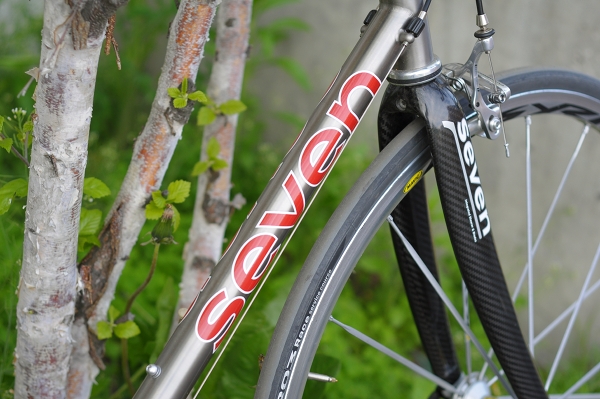 I don't know how to describe the Seven without a reference point. Ideally, I would like tohave something to compare it to other than lugged steel and a couple of very brief aluminum and carbon fiber experiences. But speakingfrom my current, limited viewpoint, I can only describe the sensation as "extreme road dampening" - to the point of not being able to feel the ground. This is a different feeling from the way fat tires roll over potholes, or a flexible steel frame dampens shock. This is something else, and it feels weird. It's like the ground isn't there. I see the bump. I see my 23mm front tire start going over the bump. But I don't feel it. Throughout this, the frame and fork are very stiff - there is hardy any flex at all. Having thought that flexible frames dampened shock and stiff frames translate into harsh rides, I am a little confused.
I don't know how to describe the Seven without a reference point. Ideally, I would like tohave something to compare it to other than lugged steel and a couple of very brief aluminum and carbon fiber experiences. But speakingfrom my current, limited viewpoint, I can only describe the sensation as "extreme road dampening" - to the point of not being able to feel the ground. This is a different feeling from the way fat tires roll over potholes, or a flexible steel frame dampens shock. This is something else, and it feels weird. It's like the ground isn't there. I see the bump. I see my 23mm front tire start going over the bump. But I don't feel it. Throughout this, the frame and fork are very stiff - there is hardy any flex at all. Having thought that flexible frames dampened shock and stiff frames translate into harsh rides, I am a little confused. Furthermore - and this is even harder to put into words - it is as if I can't feel the bike while I am riding it. I feel the cranks being turned by my legs, I feel the handlebars at the points where I am holding them, and I feel my butt on the saddle... but the frame feels almost absent.
Furthermore - and this is even harder to put into words - it is as if I can't feel the bike while I am riding it. I feel the cranks being turned by my legs, I feel the handlebars at the points where I am holding them, and I feel my butt on the saddle... but the frame feels almost absent. The combination of these sensations leaves me with adisembodied feeling - as if I am floating above the road instead of making contact with it.Is that a good thing?
The combination of these sensations leaves me with adisembodied feeling - as if I am floating above the road instead of making contact with it.Is that a good thing? With its sleek titanium surface, curved stays and ethereal ride quality, the Sevento me is like some alien machine rather than a bike. I've gone on four rides on it so far, and I feel comfortable with its precise, stable and distinctly non-twitchy handling. But the "floaty" feeling puzzles me.
With its sleek titanium surface, curved stays and ethereal ride quality, the Sevento me is like some alien machine rather than a bike. I've gone on four rides on it so far, and I feel comfortable with its precise, stable and distinctly non-twitchy handling. But the "floaty" feeling puzzles me. It's been raining here non stop for over a week, yet I've been stubbornly cycling. Covered in a layer of crud after such rides,the Sevenseems more down to earth and I find myself welcoming that. When clean, the titanium has an almost clinical quality that intimidates me, but the dirt makes it warmer and less machine-like. Maybe it is a bike after all.
It's been raining here non stop for over a week, yet I've been stubbornly cycling. Covered in a layer of crud after such rides,the Sevenseems more down to earth and I find myself welcoming that. When clean, the titanium has an almost clinical quality that intimidates me, but the dirt makes it warmer and less machine-like. Maybe it is a bike after all.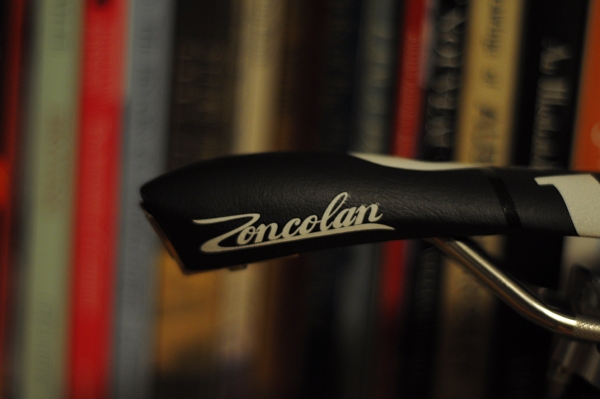 Hopefully the rain will soon stop,so that I can practice some hills and see how the Seven really compares to my other bikes. I am sure it will be faster, but will it feel safe?The fact that I am comfortable riding it in the rain is a good sign, but I'd like to learn more about its handling, especially on descents. And I would love to know how a bicycle this stiff and aggressive can produce such an extreme road dampening effect.
Hopefully the rain will soon stop,so that I can practice some hills and see how the Seven really compares to my other bikes. I am sure it will be faster, but will it feel safe?The fact that I am comfortable riding it in the rain is a good sign, but I'd like to learn more about its handling, especially on descents. And I would love to know how a bicycle this stiff and aggressive can produce such an extreme road dampening effect.What are your thoughts on titanium frames?
Friday, June 10, 2011
Kayaking Devilfish Lake

Today was our Saturday and it was forecast to be a beautiful day, so we loaded the kayaks on to the car and headed up the Arrowhead Trail to do some paddling. Our destination was Devilfish Lake. I have photographed the northern lights several times from the public landing on Devilfish and been intrigued for a while to see what the rest of the lake looked like. The shoreline of the lake is spectacular, with giant white pine trees lining the banks. Several of the trees are leaning quite a ways out over the water, like this one that I photographed Jessica paddling under. As she glided under the tree she raised her arms to feel the pine needles brush against her fingertips. We were hoping to see Loons during our paddle, but sadly we did not. Still, it was a beautiful day to be out in the kayaks!
Thursday, June 9, 2011
Summer OR show SLC 8/3 through 8/7
I'm not posting live from the summer OR show as I have done at the winter shows in the past. But obviously a few things are leaking out. The Blue IceWarthog pack and the Petzl Lynx crampon are two early examples. There is more to come. Old and new technology being show cased. Pictured are some wild ones and some old stand bys from the past and a fewcurrent "game changers" thrown in. Just to get the process going :)







 I am sworn to secrecy for a few more days. But I have to say...some of this stuff I hadn't even dreamed of yet. And that is a long list of gear dreams when you start talking about ice gear and technical boots.
I am sworn to secrecy for a few more days. But I have to say...some of this stuff I hadn't even dreamed of yet. And that is a long list of gear dreams when you start talking about ice gear and technical boots.
The Summer OR Show gives retailers a chance to see what will be available for Spring delivery and in some rare instances a few things that will be available for Fall 11. But most new Fall items are generally shown at the winter OR show the previousJan. Delivery for the Winter OR show is Fall of that year, a full 9 months later. So Winter OR will show clothing,ski and climbing gear available in the stores the Fall of . Summer OR shows the summer sporting goods and clothing that will be available in the spring of the following year. Hopefully that makes sense.
More to come by the end of the week.







 I am sworn to secrecy for a few more days. But I have to say...some of this stuff I hadn't even dreamed of yet. And that is a long list of gear dreams when you start talking about ice gear and technical boots.
I am sworn to secrecy for a few more days. But I have to say...some of this stuff I hadn't even dreamed of yet. And that is a long list of gear dreams when you start talking about ice gear and technical boots.The Summer OR Show gives retailers a chance to see what will be available for Spring delivery and in some rare instances a few things that will be available for Fall 11. But most new Fall items are generally shown at the winter OR show the previousJan. Delivery for the Winter OR show is Fall of that year, a full 9 months later. So Winter OR will show clothing,ski and climbing gear available in the stores the Fall of . Summer OR shows the summer sporting goods and clothing that will be available in the spring of the following year. Hopefully that makes sense.
More to come by the end of the week.
Tuesday, June 7, 2011
Cycling and Statistics
As someone with a background in the social and natural sciences, I was "raised" on statistics by the academic system. If we compare academia to religion, then making claims without statistical evidence is akin to taking the Lord's name in vain. But even beyond academia, we have an inherent faith in statistics as a culture. We respect numbers and charts, and we turn to them for comfort at times of uncertainty. Consider, for instance, this beautiful bar graph:
 Now, some of us may have suspected that diamond frames tend to be ridden by men, whereas step-throughs and mixtes tend to be ridden by women, but only numbers and graphs have the power to lift us from the murky waters of speculation. We can now say that, in a recent poll conducted by Lovely Bicycle, of the 221 respondents who claimed to ride mainly diamond frame bikes for transportation, 76% were male. Of the 95 respondents who claimed to ride mainly step-through bikes for transportation, 80% were female. And of the 39 respondents who claimed to ride mainly mixte bikes for transportation, 66% were female. This numerical evidence we can wield like a mighty weapon the next time someone contradicts these tendencies.
Now, some of us may have suspected that diamond frames tend to be ridden by men, whereas step-throughs and mixtes tend to be ridden by women, but only numbers and graphs have the power to lift us from the murky waters of speculation. We can now say that, in a recent poll conducted by Lovely Bicycle, of the 221 respondents who claimed to ride mainly diamond frame bikes for transportation, 76% were male. Of the 95 respondents who claimed to ride mainly step-through bikes for transportation, 80% were female. And of the 39 respondents who claimed to ride mainly mixte bikes for transportation, 66% were female. This numerical evidence we can wield like a mighty weapon the next time someone contradicts these tendencies.
Of course the one little problem with Statistics, is that it's mostly BS. In the words of comedian Vic Reeves, "88.2% of Statistics are made up on the spot" - which may very well be the case. But numbers need not be maliciously forged in order to misrepresent reality. There are multitudes of ways in which a study can be flawed or biased from the start, set up so as to elicit particular responses. Often this is done unintentionally, or at least unconsciously, by researchers eager to find evidence for their pet theories. Other scenarios can include how data is processed, or even how the final results are presented. Statistics are highly prone to human error and bias, which means that they are inherently subjective. This, combined with the fact that we respect them so much, makes our statistics-loving culture susceptible to misinformation.
 [image via NHTSA]
[image via NHTSA]
The idea of statistics and misinformation brings me to what I really wanted to talk about here, and this is something I've been trying to make sense of for a while. I am puzzled by the use of safety statistics in bicycle advocacy, and I am hoping that someone could explain them to me. For example, many bicycle advocacy talks and internet presentations stress that it is safer to ride a bike than it is to travel in a car. In support of this, they use statistics such as this data from the National Highway Traffic Safety Administration (NHTSA), according to which there were about 30,000 motor vehicle traffic fatalities, and about 600 bicycle fatalities in the USA in . These numbers are used by cycling advocates to point out how much safer it is to cycle than to drive. But unless I am missing something, the figures mean just the opposite.
Yes, the NHTSA numbers suggest that in there were 50 times more motor vehicle fatalities than there were bicycle fatalities in the US. But those numbers mean nothing until they are weighed against how many cars vs bicycles there are on the roads at large. If there were 50 times more cars on the road than bicycles, than the risks of fatal traffic accident would be equal for each mode of transportation. But I believe that in actuality, there are more like 1,000 more cars on the roads than bicycles... which means that the number of cycling fatalities is disproportionately high.
Obviously, I am not trying to prove that cycling is unsafe. ButI do want to understand the reality of the situation. After all, if cycling advocates use statistics incorrectly, they open themselves up to some very harsh critique from unfriendly forces. Where could one go to obtain accurate statistics about the number of cars vs bicycles on the roads, and the number of traffic accidents for each?
 Now, some of us may have suspected that diamond frames tend to be ridden by men, whereas step-throughs and mixtes tend to be ridden by women, but only numbers and graphs have the power to lift us from the murky waters of speculation. We can now say that, in a recent poll conducted by Lovely Bicycle, of the 221 respondents who claimed to ride mainly diamond frame bikes for transportation, 76% were male. Of the 95 respondents who claimed to ride mainly step-through bikes for transportation, 80% were female. And of the 39 respondents who claimed to ride mainly mixte bikes for transportation, 66% were female. This numerical evidence we can wield like a mighty weapon the next time someone contradicts these tendencies.
Now, some of us may have suspected that diamond frames tend to be ridden by men, whereas step-throughs and mixtes tend to be ridden by women, but only numbers and graphs have the power to lift us from the murky waters of speculation. We can now say that, in a recent poll conducted by Lovely Bicycle, of the 221 respondents who claimed to ride mainly diamond frame bikes for transportation, 76% were male. Of the 95 respondents who claimed to ride mainly step-through bikes for transportation, 80% were female. And of the 39 respondents who claimed to ride mainly mixte bikes for transportation, 66% were female. This numerical evidence we can wield like a mighty weapon the next time someone contradicts these tendencies. Of course the one little problem with Statistics, is that it's mostly BS. In the words of comedian Vic Reeves, "88.2% of Statistics are made up on the spot" - which may very well be the case. But numbers need not be maliciously forged in order to misrepresent reality. There are multitudes of ways in which a study can be flawed or biased from the start, set up so as to elicit particular responses. Often this is done unintentionally, or at least unconsciously, by researchers eager to find evidence for their pet theories. Other scenarios can include how data is processed, or even how the final results are presented. Statistics are highly prone to human error and bias, which means that they are inherently subjective. This, combined with the fact that we respect them so much, makes our statistics-loving culture susceptible to misinformation.
 [image via NHTSA]
[image via NHTSA]The idea of statistics and misinformation brings me to what I really wanted to talk about here, and this is something I've been trying to make sense of for a while. I am puzzled by the use of safety statistics in bicycle advocacy, and I am hoping that someone could explain them to me. For example, many bicycle advocacy talks and internet presentations stress that it is safer to ride a bike than it is to travel in a car. In support of this, they use statistics such as this data from the National Highway Traffic Safety Administration (NHTSA), according to which there were about 30,000 motor vehicle traffic fatalities, and about 600 bicycle fatalities in the USA in . These numbers are used by cycling advocates to point out how much safer it is to cycle than to drive. But unless I am missing something, the figures mean just the opposite.
Yes, the NHTSA numbers suggest that in there were 50 times more motor vehicle fatalities than there were bicycle fatalities in the US. But those numbers mean nothing until they are weighed against how many cars vs bicycles there are on the roads at large. If there were 50 times more cars on the road than bicycles, than the risks of fatal traffic accident would be equal for each mode of transportation. But I believe that in actuality, there are more like 1,000 more cars on the roads than bicycles... which means that the number of cycling fatalities is disproportionately high.
Obviously, I am not trying to prove that cycling is unsafe. ButI do want to understand the reality of the situation. After all, if cycling advocates use statistics incorrectly, they open themselves up to some very harsh critique from unfriendly forces. Where could one go to obtain accurate statistics about the number of cars vs bicycles on the roads, and the number of traffic accidents for each?
Subscribe to:
Comments (Atom)
